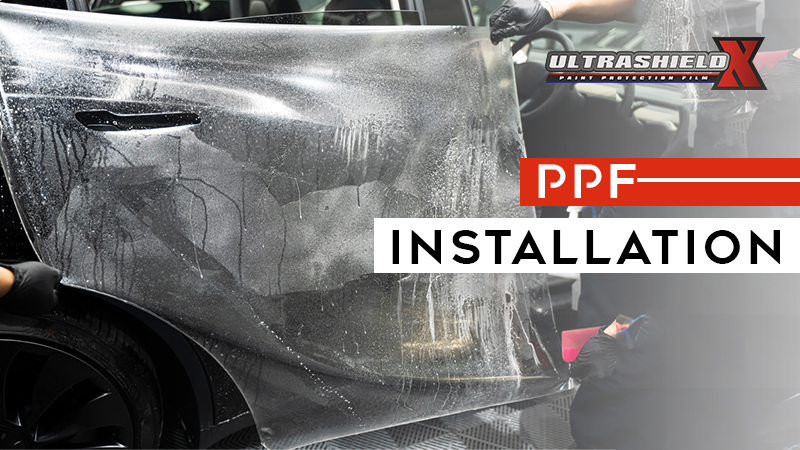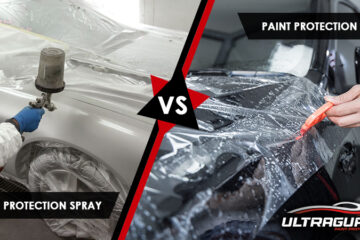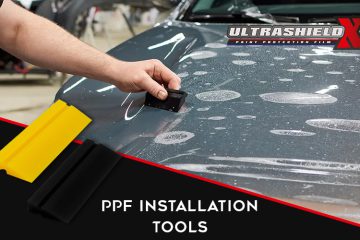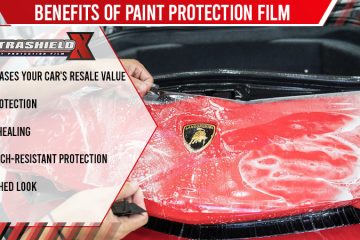Paint protection films are an invisible cape to shield your vehicle from stone chips, debris, gravel, and other paint-damaging contaminants. These films also block UV rays, which leads to paint discolouration.

PPF Installation
Knowing the proper steps for PPF installation is essential to ensure the PPF blends seamlessly with the vehicle’s surface. This blog will discuss “how to install paint protection film”.
How to Install Paint Protection Film: 10-step guide
Here’s a simple guide on how to install PPF like a professional detailer:
Step 1: Choose Your Film

Choose Your Film
Initially, the first step before starting the installation is to decide on the type of film you want for your vehicle. Since investing in PPF is a one-time affair, we highly recommend opting for a high-quality PPF. Moreover, these protective films come in various textures and finishes, including options like matte, gloss, colour, and textured.
Step 2: Prepare The Working Area

prepare the working area
Ensure the area in which you will do the installation process is dust-free and clean. This will eliminate the risk of dust particles trapped under the film. Also, you need adequate tools, including a squeegee, a spray bottle filled with a soap-water solution, and a sharp knife or blade.
Step 3: Clean The Car

clean the car
You should wash your car entirely and ensure no dirt or grime is left on the surface. Also, paying extra attention to the areas where you’ll apply the film would be best. After cleaning the surface, use a clay bar to remove any remaining mineral contaminants from the paint.
Step 4: Measure and Cut

Measure and Cut
Paint protection film installers will carefully measure the film and cut it according to the panel of the car you are covering. It is essential to leave a bit of extra margin around the edges for adjustment.
Step 5: Apply Soap Water

Apply Soap Water
Use mild soap water and spray all over the area on which you are applying the film. This step is essential because this solution will prevent the film from sticking immediately, allowing you to settle on the vehicle’s surface and put it in the perfect position.
Step 6: Apply the Film

Apply the Film
Carefully place the film onto the wet surface, starting from one end and gradually laying it down to avoid air bubbles. Don’t worry if it’s not perfect on the first try; you can gently lift and reapply as needed.
Step 7: Squeegee Out the Bubbles

Squeegee Out the Bubbles
After you have placed the film in position, use a squeegee to push out excess air bubbles. Be gentle enough to ensure the film sticks smoothly to the car’s surface during this process.
Step 8: Trim the Edges

Trim the Edges
There is excess film around the edges after placing the PPF. With the help of a sharp knife or blade, trim off the edges.
Step 9: Let the PPF Settle

Let the PPF Settle
You should allow the film to dry completely. It generally takes 1-2 days to settle, depending on the temperature of the environment. Once the surface is dry, inspect your work for any bubbles or imperfections.
Step 10: Care for Your Film

Care for your car
Wait to drive your vehicle for at least a week after the installation. Also, you must wash your car promptly and avoid harsh chemicals.
Factors Affecting PPF Installation Cost
Paint protection film installation cost depends on several factors, such as film quality, vehicle size, installer, and location. Here’s a simple breakdown:
1.) Film quality:
The brand of PPF and the type of film you choose determine the installation cost. Generally, high-quality films are more expensive, and unique films like coloured and textured ones cost a bit more.
2.) Vehicle’s Size:
Cars like SUVs require more film and have panels with complex curves on which the detailer has to work carefully. This will increase the cost.
3.) Area to be Covered:
It’s your choice to protect the entire body or select high-impact areas. Full coverage is more expensive than partial coverage.
4.) Detailer’s Experience:
As quality comes with a price; a professional detailer will charge you more because of their expertise and quality work.
5.) Location:
Prices can vary depending on where you live. In areas with higher living costs, PPF installation might be more expensive.
What is the Average Paint Protection Film Installation Cost?
Usually, for a small car, the cost might start from Rs. 75,000. For bigger cars or more coverage, it could be more. Remember, the price can change based on where you live and who does the work. It’s a good idea to check with a few places to get the best deal.
Conclusion
To wrap up, achieving a flawless finish from the installation relies solely on the application method and the skill of the installer. Trust an experienced PPF installer for the best results. To find the top detailer, ask around for recommendations or simply Google ‘PPF installer near me’ to get their details.
Frequently Asked Questions (F.A.Qs)
1.) Can I install the paint protection film myself?
It is strongly advised to find a professional PPF detailer or go to a reputed detailing studio and avoid installing PPF by yourself. There are many DIY PPF options, but they may lead to improper fitting or might damage the vehicle’s surface.
2.) How is paint protection film installed?
The PPF installation process is not a layman’s job. The process includes:
- Cleaning and prepping the surface
- Carefully cut the PPF
- Using a mild soap solution, apply the film to the surface
- Finally, use a squeegee to remove air bubbles and ensure a smooth installation.
3.) Is PPF worth it?
The PPF installation price is worth every penny spent. It will act as a protective barrier for your vehicle for a minimum of 5 years. Also, it will prevent discolouration and corrosion of the paint, which will help to preserve the resale value of the vehicle.
4.) How long after PPF can you drive?
It is advised not to drive the car for a week after installation. You should wait at least 7 days for PPF to cure and settle on the vehicle’s surface.
5.) Does PPF increase car value?
Yes, PPF will increase your car’s resale worth. No buyer is interested in a discoloured and scratched car, but PPF will preserve the vehicle’s shine for years. Future buyers will pay more for a well-preserved car.
6.) How many years does paint protection film last?
If you properly maintain the PPF, it will last between 7-10 years. Generally, a car owner sells their vehicle every 8 years on average, so many people enjoy its benefits even for a lifetime.
7.) Can you ceramic coat over PPF?
Yes, it is a common practice in the industry to ceramic coat a PPF-protected surface. The PPF must always be installed first before coating. Ceramic Coating will create an additional hydrophobic layer on the surface and will make the cleaning process easier.
9.) Does PPF change car colour?
PPF does not alter the vehicle’s colour. Applying paint protection film on vehicles, blocks UV rays, thereby maintaining the showroom finish of the paintwork for years.





0 Comments